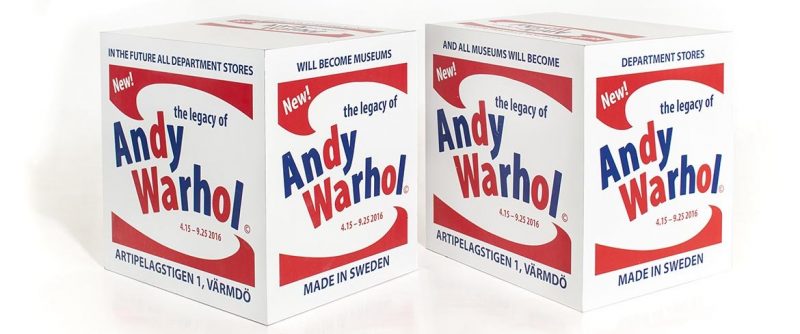The Legacy of Andy Warhol

On the exhibition
Andy Warhol is one of the most influential artists of the 20th century. The myriad exhibitions about him testify to this; last year alone, his works were featured in more than 30 shows globally, and were seen by a broad public all over the world.
Most of these exhibitions are blockbusters, showing a large number of works, and focusing on Warhol’s oeuvre. But Warhol is interesting not only as an artist. His influence stretches far beyond the field of art, as seen in the wide range of Warhol-related events in recent years. Warhol has also been a pioneer in music, fashion, advertising, media, communications and consumption – in short, what is today called lifestyle.
In the exhibition The Legacy of Andy Warhol, our frame of reference is Warhol’s development as an artist, based on his autobiography, Andy Warhol From A to B and Back Again. Warhol found inspiration in daily papers and magazines, which he transformed into commercial products such as advertisements, illustrations and record sleeves. This is where Warhol’s fascination for glamour and commerce began, eventually becoming a central aspect of his entire oeuvre. The exhibition features some 40 of these drawings from the 1950s.
The section with works from the 1960s centres on Warhol’s artistic practice. Warhol made his breakthrough as an artist in 1962 with his now famous paintings of Campbell’s soup cans, but his output from the 1960s also includes pictures of accidents and film stars. The exhibition includes a reconstruction of his studio, The Factory, with its silver foil interior. Here, art was produced on an industrial scale. Warhol challenged the notions of art’s originality and authenticity, leaving his staff to make the art works for him. The Factory was not only a studio but also a social forum, where movies were shot with a cast of disparate people Warhol labelled as “superstars”. Pop music was one of the most important cultural expressions of the 1960s. The Velvet Underground is the rock group that is most closely associated with Andy Warhol and The Factory. It was around their music that Warhol produced his most complex work of art, The Exploding Plastic Inevitable from 1966, a multimedia show that, in addition to music, incorporated Warhol’s films, projections and dance.
The result was a revolutionary physical experience that inspired many other stage shows and music videos. The Exploding Plastic Inevitable made music an essential part of the visual culture. In this exhibition we present unique material in the form of a video installation with footage filmed by Ronald Nameth for Andy Warhol in 1966, accompanied by original recordings of The Velvet Underground.
The 1970s part of the exhibition shows how Warhol’s activities changed from the open access of The Factory, to a more business-like arts corporation. Warhol still insisted on creating art that was emancipating, both in terms of politics and morals, not least by challenging the boundaries of sexual identity. The American market was not ready for Warhol’s provocations, however, and he had greater success internationally, mainly in Europe. In this situation, portrait commissions saved the day. Warhol offered to depict the rich and famous, and this introduced him to New York’s hippest crowd. Warhol became a voyeuristic observer of the artificial paradise of disco culture. In the 1980s, Warhol’s artistic practice appears to have been in harmony with the Zeitgeist. He gave up his provocative approach in favour of commerce, the most flagrant cultural style of that decade. Warhol was celebrated as a trailblazer for artists such as Cindy Sherman and Richard Prince, but also for those like Jean-Michel Basquiat and Keith Haring, with roots in graffiti and street art. Warhol’s influence on the art scene was also expressed in unabashed “appropriations” of his art, where artists such as Mike Bidlo, Richard Pettibone, Vik Muniz and others borrowed directly from Warhol’s imagery. This art form is also represented in the exhibition.
In 1987, Warhol died following a standard surgical procedure, and his estate became the subject of an almost unprecedented grab fest. The Andy Warhol Foundation rose like a phoenix from the ashes, and the Andy Warhol Museum opened in 1994 in Pittsburgh where he was born.
A special feature of this exhibition is our Pop-Up Store, where we present the commercialisation of Warhol’s trademark and imagery that he himself promoted during his lifetime, a process that has escalated since his death. Today, the Andy Warhol Foundation guards and manages the licence rights to Warhol’s works with an iron fist, applying a fiercely restrictive policy on use, with a focus on product development and creativity. Therefore, the exhibition highlights a few product categories that have been launched on the market in recent years, including baby buggies (Bugaboo), hats (Philip Treacy), clothing (WESC), sports goods (Burton), and cosmetics (Nars). This is a multifaceted product range that can be found in any department store, and its focus on youth culture seems like a logical sequel to Warhol’s own interest in pop culture. Andy Warhol would probably brush away any objections to this commercialism, especially since the profits will go to young artists through organisations in the American arts sector.
Curators
Bo Nilsson, Art Director, Artipelag.
Frida Andersson, Jessica Höglund, Artipelag.
Press images
Available in our press room.
Press contact
Maria Rosén, maria.rosen@artipelag.se, tel +46 (0)72 080 10 53
About Artipelag
Artipelag is a new Swedish international meeting place for art exhibitions, cultural activities, architecture, music, Swedish design and excellent food in a beautiful archipelago setting. Artipelag is situated at Hålludden on the island of Värmdö, ca 20 km east of Stockholm. Artipelag was designed by the late architect Johan Nyrén, and commissioned by the family firm BabyBjörn AB. In addition to cultural activities in a setting of stunning natural beauty, Artipelag has two restaurants, with outdoor seating, conference facilities, and an artbox for 1,000 people suitable for events and television productions as well as a design store.